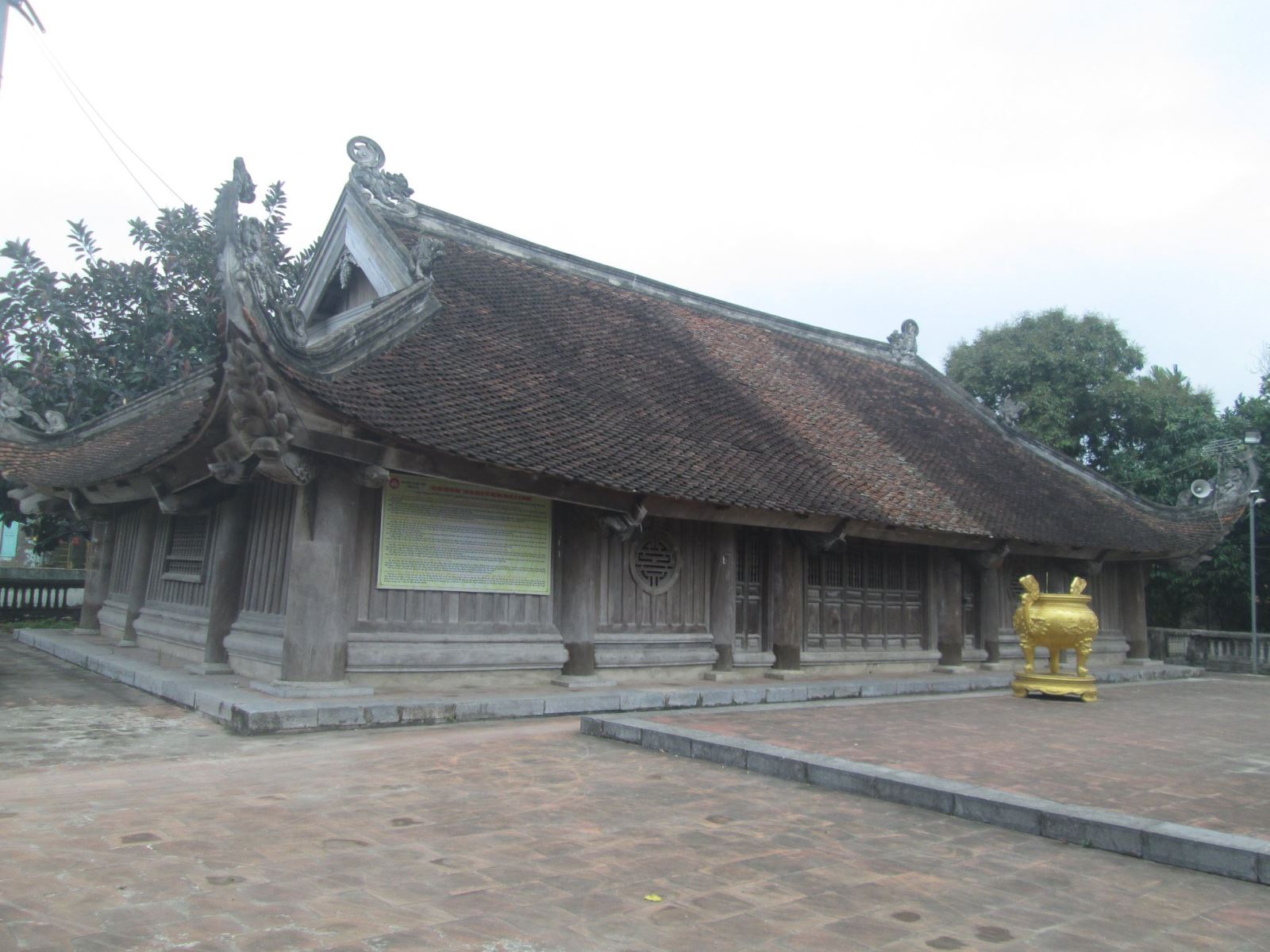The Artistic and Architectural Legacy of Vi Ha Communal House in the Heart of Ha Nam
Amidst the ceaseless flow of time, Vi Ha Communal House stands resilient - an enduring witness to history, imbued with the cultural, spiritual, and artistic essence of traditional Vietnamese architecture. Nestled peacefully in Vi Ha hamlet, Trung Luong commune, Binh Luc district, Ha Nam province, this ancient communal house exudes a quiet solemnity, embodying the elegant charm of Late Le dynasty woodcarving art. A visit to Vi Ha allows guests to admire an architectural masterpiece steeped in historical legacy and to explore the spiritual life and deep - rooted traditions of the Red River Delta.
Location and Historical Origins
Conveniently situated near National Highway 21, on the route connecting Ha Nam to Nam Dinh and Thai Binh, Vi Ha Communal House serves as an ideal stopover for those journeying through the region’s spiritual and cultural landmarks. Just a short distance away, the well - known Nguyen Khuyen street adds to the rich heritage cluster of Trung Luong.

According to historical records, the communal house was constructed during the flourishing Late Le dynasty - a golden era for Vietnamese village architecture. Despite the passage of centuries, the structure has withstood the test of time, retaining its sacred, timeworn beauty and becoming a symbol of pride for the local people.
A Masterpiece of Harmonious Design and Artistry
Stepping through its gates, visitors are immediately captivated by the traditional Đinh (丁) - shaped layout. The complex comprises two main structures: a spacious Tien Duong (Front Hall) with five bays and a dignified Chinh Tam (Main Sanctuary) with three bays. This arrangement ensures both visual harmony and architectural strength, reflecting the sacred significance of the space.
A Masterpiece of Harmonious Design and Artistry
Stepping through its gates, visitors are immediately captivated by the traditional Đinh (丁) - shaped layout. The complex comprises two main structures: a spacious Tien Duong (Front Hall) with five bays and a dignified Chinh Tam (Main Sanctuary) with three bays. This arrangement ensures both visual harmony and architectural strength, reflecting the sacred significance of the space.

The curving tiled roof, clad with traditional “mũi hài” tiles, lends a stately presence. The intricately carved columns, lacquered red - gold horizontal panels, and parallel verses exemplify the refined artistry of the Late Le period. Flowing motifs of dragons, phoenixes, and floral patterns sculpted on ironwood beams form a vibrant tableau, showcasing the masterful craftsmanship of ancient artisans.
Standing prominently in the courtyard is the ancient Vi Thi Kieu Stele - a sculptural treasure symbolizing the connection between communal houses and community life. The quadrangular stele, 0.95m tall and 0.41m wide, is adorned with detailed carvings of the Four Sacred Beasts (dragon, unicorn, turtle, phoenix) set against elaborate brocade patterns. Topped with a Long Dinh (Dragon Pavilion), it exudes grandeur and reverence. These intricate designs not only reflect exceptional artistic skill but also carry spiritual symbolism, representing the prosperity and harmony of the village.
A Sanctuary Honoring National Heroes
Standing prominently in the courtyard is the ancient Vi Thi Kieu Stele - a sculptural treasure symbolizing the connection between communal houses and community life. The quadrangular stele, 0.95m tall and 0.41m wide, is adorned with detailed carvings of the Four Sacred Beasts (dragon, unicorn, turtle, phoenix) set against elaborate brocade patterns. Topped with a Long Dinh (Dragon Pavilion), it exudes grandeur and reverence. These intricate designs not only reflect exceptional artistic skill but also carry spiritual symbolism, representing the prosperity and harmony of the village.
A Sanctuary Honoring National Heroes

Beyond its architectural grandeur, Vi Ha Communal House serves as a place of worship for deities and revered generals who contributed greatly to the nation. Among those venerated are:
- Lang Vuong Cu Si – a sacred guardian believed to protect the village’s peace;
- Thien Cuong Dinh Cat Ton Than – symbolizing divine protection and national safeguarding;
- Dong Hai Dai Vuong Nguyen Phuc – a distinguished general of the Early Le dynasty, honored for expanding and defending the realm;
- Chu Duong Dai Vuong – a valiant warrior who helped maintain the region’s tranquility.
Each year, during traditional festivals, Vi Ha becomes a ceremonial epicenter, where solemn rites draw locals and pilgrims alike. The sacred atmosphere, combined with the resounding beat of festival drums, brings forth a lively yet dignified celebration of national spirit and ancestral reverence.
A Lasting Spiritual and Cultural Heritage
As one of the few communal houses that still retains the Late Le architectural style in near - original form, Vi Ha stands out for its deep historical and artistic values. Every carved detail reflects the virtuosity of its artisans; each lacquered panel and golden - inscribed couplet carries philosophical wisdom and regal elegance. This seamless integration of spiritual tradition and aesthetic artistry transforms Vi Ha into a “living museum” of Vietnamese village architecture - unmatched in its authenticity.
The communal house is not only a sacred space for Trung Luong villagers but also an alluring destination for culture enthusiasts and heritage explorers. For travelers across the Northern Delta, a stop here offers the rare opportunity to witness ancient Vietnamese craftsmanship firsthand. Amidst its tranquil setting, the communal house exudes a serene charm - an invitation to reflect and find inner peace amid life’s hustle.
Beyond its architectural marvels, Vi Ha preserves invaluable intangible heritage. Its annual festivals re - enact ancient spiritual rituals and showcase traditional customs rich in symbolism. These events not only strengthen communal bonds but also play a vital role in safeguarding the spiritual heart of village life.
Through centuries of historical change, Vi Ha Communal House remains - steadfast and solemn. More than a place of worship, it is an artistic masterpiece and a cultural beacon where national spirit, communal memory, and lasting heritage converge.
A single visit to Vi Ha allows one to sense the noble grace of a time - honored monument, to listen to the echoes of heroic tales within its silent halls - and, above all, to cherish the enduring legacy passed down by our forebears.
Come, experience, and let Vi Ha Communal House lead you into the proud cultural current of Ha Nam.
A Lasting Spiritual and Cultural Heritage
As one of the few communal houses that still retains the Late Le architectural style in near - original form, Vi Ha stands out for its deep historical and artistic values. Every carved detail reflects the virtuosity of its artisans; each lacquered panel and golden - inscribed couplet carries philosophical wisdom and regal elegance. This seamless integration of spiritual tradition and aesthetic artistry transforms Vi Ha into a “living museum” of Vietnamese village architecture - unmatched in its authenticity.
The communal house is not only a sacred space for Trung Luong villagers but also an alluring destination for culture enthusiasts and heritage explorers. For travelers across the Northern Delta, a stop here offers the rare opportunity to witness ancient Vietnamese craftsmanship firsthand. Amidst its tranquil setting, the communal house exudes a serene charm - an invitation to reflect and find inner peace amid life’s hustle.
Beyond its architectural marvels, Vi Ha preserves invaluable intangible heritage. Its annual festivals re - enact ancient spiritual rituals and showcase traditional customs rich in symbolism. These events not only strengthen communal bonds but also play a vital role in safeguarding the spiritual heart of village life.
Through centuries of historical change, Vi Ha Communal House remains - steadfast and solemn. More than a place of worship, it is an artistic masterpiece and a cultural beacon where national spirit, communal memory, and lasting heritage converge.
A single visit to Vi Ha allows one to sense the noble grace of a time - honored monument, to listen to the echoes of heroic tales within its silent halls - and, above all, to cherish the enduring legacy passed down by our forebears.
Come, experience, and let Vi Ha Communal House lead you into the proud cultural current of Ha Nam.










